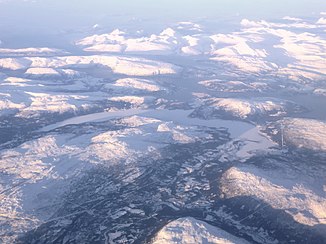Røssåga
| Røssåga | ||
|
Aerial view: Røssåga in winter |
||
| Data | ||
| Water code | NO : 155.Z | |
| location | Hemnes municipality in Nordland ( Norway ) | |
| River system | Røssåga | |
| Drain over | Røssåga → Atlantic Ocean | |
| origin | in the lake Røssvatnet 65 ° 51 ′ 27 ″ N , 13 ° 47 ′ 43 ″ E |
|
| Source height | 383 m | |
| muzzle | in the Sørfjord coordinates: 66 ° 9 ′ 39 ″ N , 13 ° 48 ′ 9 ″ E 66 ° 9 ′ 39 ″ N , 13 ° 48 ′ 9 ″ E |
|
| Mouth height | 0 m | |
| Height difference | 383 m | |
| Bottom slope | 7.7 ‰ | |
| length | 50 km | |
| Catchment area | 2100 km² | |
| Right tributaries | Bleikvasselva , Bjuråga , Leirelva | |
| Flowing lakes | Røssvatnet | |
| Reservoirs flowed through | Stormyrbassenget | |
The Røssåga is a river in the municipality Hemnes in the Fylke Nordland . It has its origin in the lake Røssvatnet and flows in a northerly direction through a relatively wide valley until it flows into the Sørfjord , an arm of the Ranfjord , near Bjerka . The tributaries Bleikvasselva , Bjuråga and Leirelva flow into the Røssåga from the east . The Røssåga is 50 km long and has a catchment area of around 2100 km².
Use of hydropower
The Røssåga is one of the rivers in Norway whose hydropower is most widely used for energy generation. In 1958 the Nedre Røssåga power plant was completed, and Øvre Røssåga power plant in 1962 . They are used to power the energy-intensive industries in the region, including the Norsk Jernverk ironworks in Mo i Rana and the Mosal aluminum works in Mosjøen .
| Surname | completion position |
Power in MW |
Annual output in GWh |
Fall height in m |
Number of turbines |
Reservoir | operator |
|---|---|---|---|---|---|---|---|
| Øvre Røssåga Kraftverk | 1962 | 187 | 907 | 135 | 3 | Røssvatn , Bleikvatnet | Statkraft |
| Nedre Røssåga Kraftverk | 1958 | 300 | 1827 | 246 | 6th | Stormyrbassenget | Statkraft |
fauna
The Røssåga was originally an important salmon river . However, the stock of salmon has declined due to the significant regulation of the watercourse. In 1980 the salmon parasite Gyrodactylus salaris was discovered in the river. In 2003 and 2004 the Røssåga underwent chemical treatment to remove the parasite. The Røssåga has been considered parasite-free since 2009. The salmon population has since recovered and is said to have returned to its original state in 2015.
